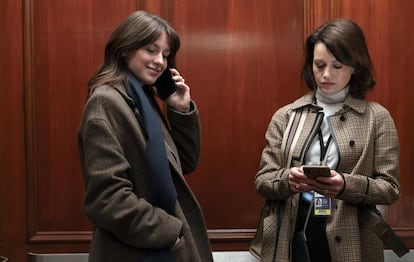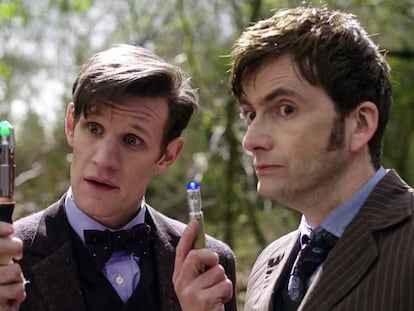‘The Girls on the Bus’: A failed attempt to strike back against the cliché of the slutty reporter
Inspired by the memoirs of a ‘New York Times’ reporter, the show aims to settle the score against toxic stereotypes by following four female journalists covering a presidential campaign


The world’s worst journalists are not found in a newsroom. They are in the stories that appear on our screens. For decades, the trail of their questionable practice has been followed in shows and movies, regardless of whether they were intense political thrillers, forgettable romantic comedies or adaptations of real cases that shocked the world. It didn’t matter what genre they were set in. The same pattern has been repeated tirelessly over and over again: at some point in the plot, the reporter would end up exchanging sex for information. It’s as if being a woman and a journalist made it essential to take off her clothes for the public good. All these stories embraced the cliché of the slutty journalist.
Sally Field slept with her source, Paul Newman, in Absence of Malice (1981). Katie Holmes went for it in the controversial and much talked about sex scene in Thank You for Smoking (2005). In a lousy move for her future, Kate Mara did the same with Kevin Spacey in House of Cards (2013). An alcoholic seductress and liar, Amy Adams played the journalist who angered the union the most in Sharp Objects (2018). In the epilogue of Gilmore Girls, the upright Rory also ended up drunkenly bedding one of her informants, dressed as Chewbacca. Even Clint Eastwood fell for this trope in Richard Jewell (2019), when he decided that this was how Kathy Scruggs (played in the film by Olivia Wilde) — the Atlanta Journal-Constitution (AJC) journalist who reported on the FBI’s investigation of the juicy case of a security guard at the Atlanta Olympics who spotted a suspicious backpack with an explosive — should get her scoop. The newspaper released a statement criticizing the film to no avail: “The AJC’s reporter is reduced to a sex-trading object in the film…That is entirely false and malicious, and it is extremely defamatory and damaging,” the text read. But Warner Bros. turned a deaf ear, and viewers were left with that impression anyway.

Seeking to change that tired cliché and other prejudices about female journalists, The Girls on the Bus premiered on HBO Max on March 15. Created by producer Julie Plec (The Vampire Diaries) and journalist Amy Chozick, the show is a loose adaptation of Chasing Hillary, Chozick’s 2018 memoir about her coverage of Hillary Clinton’s campaign for The New York Times. Not to depress the audience, but the show doesn’t capture the sinking and paradigm-shifting nature of that presidential race that ended worse than the Titanic, with more white 20-somethings crying their eyes out than a Taylor Swift concert. Plec and Chozick have devised an alternate universe in this show, a fable whose plot orbits the presidential race of several Democratic politicians who do not exist in real life: a veteran whose age raises doubts about his suitability for office, a mayor of a town who overcomes his minimal name recognition, and a famous writer who will receive the support of a fictitious Hillary Clinton, the senator who lost the previous presidential campaign.
Between absurdity and grandiloquence — tones that do not quite go together, but are a given in journalism — and more in tune with the lightness of other journalist-focused shows like The Bold Type than with the self-conscious solemnity of The Newsroom, The Girls on the Bus is light fiction that could have been a fine parody of journalism a la Veep, but it instead preferred to get dangerously close to Shonda Rhimes’ soap opera universe without the bedroom scenes.
Overcoming viral ridicule
The protagonist is Sadie McCarthy (Melissa Benoist), a correspondent for the New York Sentinel (a fictional version of the Times), a 30-something journalist who must overcome a professional rough patch after going viral for ridiculous reasons during another Democratic campaign. Sadie has recurring visions of Hunter S. Thompson appearing to her, giving her gonzo writing advice, hardly credible for a reporter under 40 raised in the heat of fourth-wave feminism. Her editor, Bruce (Griffin Dunne, the eternal protagonist of After Hours and Joan Didion’s nephew), is inspired by Times legend David Carr, but here he appears as a more paternal figure, far from the hardened and sarcastic reporter that we see in the documentary Page One.
Sadie is joined by Grace (played by the always terrific Carla Gugino), a cynical and social media-unfriendly Pulitzer Prize-winning veteran reporter who pretends to care about her college daughters when in fact she’s using the campus visit to score a scoop. Lola (Natasha Benham) is the young woman on the campaign bus, a histrionic character who brings together all the laziest TikTok and Generation Z clichés in an irritating, over-the-top way. The fourth woman is Kimberlyn (Christina Elmore), a racialized Republican woman, a feminist who believes she will break the glass ceiling on her own merits and who works on a Fox News transcript, willing to rise above all the racist obstacles posed by her network.

Unbeatable clichés
The title of the show is a play on the title of Rolling Stone reporter Timothy Crouse’s classic piece of American political reporting, The Boys on the Bus, about the 1972 campaign between George McGovern and Richard Nixon. Perhaps that accounts for the ghost presence of Hunter S. Thompson, who wrote the book’s foreword. “We may have started out as competitors, but we ended up becoming a family,” Sadie warns at the beginning of the show, foreshadowing that the four women will discover a dark plot for which she will end up arrested. The protagonist will fight against the sexist double standards for female reporters, including that of the journalist who exchanges sex for information. Years before, she had an affair with the press secretary of the candidate she must follow (Malcolm Scott) and the sexual tension will increase as the show progresses. Her feminist prayers will not be answered.
This does not only happen in U.S. fiction. In the report La representación de la mujer periodista en el cine español (The Representation of the Female Journalist in Spanish Cinema, in English, film critic Lucía Tello analyzed how female journalists were portrayed in 600 films. In addition to finding less visibility than that of their male colleagues — they rarely appeared on-screen without the company of a man — she also warned that “many journalists have a partner or ex-partner as their companion informant.” In her study, Tello rescued two characters that “represent the role of the authentic with greater strength and forcefulness”: Najwa Nimri as Bárbara in Oviedo Express (2007), going so far as to say of her that she has her “heart between her legs,” and Mónica Randall as Esmeralda in Catorce estaciones (1991), “earning the title of ‘Hydra,’ after the mythical many-headed serpent that ended up killing Heracles, giving us an idea of how her social circle perceives the female journalist.”
With The Girls on the Bus, it seemed that it would never happen again, but the curse on the vision of female journalists remains, immutable. It’s another failed effort to strike back against the slutty journalist.
Sign up for our weekly newsletter to get more English-language news coverage from EL PAÍS USA Edition
Tu suscripción se está usando en otro dispositivo
¿Quieres añadir otro usuario a tu suscripción?
Si continúas leyendo en este dispositivo, no se podrá leer en el otro.
FlechaTu suscripción se está usando en otro dispositivo y solo puedes acceder a EL PAÍS desde un dispositivo a la vez.
Si quieres compartir tu cuenta, cambia tu suscripción a la modalidad Premium, así podrás añadir otro usuario. Cada uno accederá con su propia cuenta de email, lo que os permitirá personalizar vuestra experiencia en EL PAÍS.
¿Tienes una suscripción de empresa? Accede aquí para contratar más cuentas.
En el caso de no saber quién está usando tu cuenta, te recomendamos cambiar tu contraseña aquí.
Si decides continuar compartiendo tu cuenta, este mensaje se mostrará en tu dispositivo y en el de la otra persona que está usando tu cuenta de forma indefinida, afectando a tu experiencia de lectura. Puedes consultar aquí los términos y condiciones de la suscripción digital.
More information
Archived In
Últimas noticias
Most viewed
- Sinaloa Cartel war is taking its toll on Los Chapitos
- Oona Chaplin: ‘I told James Cameron that I was living in a treehouse and starting a permaculture project with a friend’
- Reinhard Genzel, Nobel laureate in physics: ‘One-minute videos will never give you the truth’
- Why the price of coffee has skyrocketed: from Brazilian plantations to specialty coffee houses
- Silver prices are going crazy: This is what’s fueling the rally










































